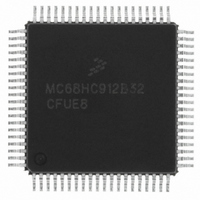MCHC912B32CFUE8 Freescale Semiconductor, MCHC912B32CFUE8 Datasheet - Page 290

MCHC912B32CFUE8
Manufacturer Part Number
MCHC912B32CFUE8
Description
IC MCU 32K FLASH 8MHZ 80-QFP
Manufacturer
Freescale Semiconductor
Series
HC12r
Datasheet
1.MCHC912B32CFUE8.pdf
(334 pages)
Specifications of MCHC912B32CFUE8
Core Processor
CPU12
Core Size
16-Bit
Speed
8MHz
Connectivity
SCI, SPI
Peripherals
POR, PWM, WDT
Number Of I /o
63
Program Memory Size
32KB (32K x 8)
Program Memory Type
FLASH
Eeprom Size
768 x 8
Ram Size
1K x 8
Voltage - Supply (vcc/vdd)
4.5 V ~ 5.5 V
Data Converters
A/D 8x10b
Oscillator Type
External
Operating Temperature
-40°C ~ 85°C
Package / Case
80-QFP
Cpu Family
HC12
Device Core Size
16b
Frequency (max)
8MHz
Interface Type
SCI/SPI
Total Internal Ram Size
1KB
# I/os (max)
63
Operating Supply Voltage (typ)
5V
Operating Supply Voltage (max)
5.5V
Operating Supply Voltage (min)
4.5V
On-chip Adc
8-chx10-bit
Instruction Set Architecture
CISC
Operating Temp Range
-40C to 85C
Operating Temperature Classification
Industrial
Mounting
Surface Mount
Pin Count
80
Package Type
PQFP
Package
80PQFP
Family Name
HC12
Maximum Speed
8 MHz
Operating Supply Voltage
5 V
Data Bus Width
16 Bit
Number Of Programmable I/os
63
Processor Series
HC912B
Core
HC12
Data Ram Size
1 KB
Maximum Clock Frequency
8 MHz
Maximum Operating Temperature
+ 85 C
Mounting Style
SMD/SMT
3rd Party Development Tools
EWHCS12
Development Tools By Supplier
M68EVB912B32E
Minimum Operating Temperature
- 40 C
Lead Free Status / RoHS Status
Lead free / RoHS Compliant
Available stocks
Company
Part Number
Manufacturer
Quantity
Price
Company:
Part Number:
MCHC912B32CFUE8
Manufacturer:
Freescale Semiconductor
Quantity:
10 000
- Current page: 290 of 334
- Download datasheet (2Mb)
Development Support
Program information is fetched a few cycles before it is used by the CPU. To monitor cycle-by-cycle CPU
activity, it is necessary to externally reconstruct what is happening in the instruction queue. Internally, the
MCU only needs to buffer the data from program fetches. For system debug it is necessary to keep the
data and its associated address in the reconstructed instruction queue. The raw signals required for
reconstruction of the queue are ADDR, DATA, R/W, ECLK, and status signals IPIPE1 and IPIPE0.
The instruction queue consists of two 16-bit queue stages and a holding latch on the input of the first
stage. To advance the queue means to move the word in the first stage to the second stage and move
the word from either the holding latch or the data bus input buffer into the first stage. To start even (or
odd) instruction means to execute the opcode in the high-order (or low-order) byte of the second stage of
the instruction queue.
18.3 Background Debug Mode (BDM)
Background debug mode (BDM) is used for system development, in-circuit testing, field testing, and
programming. BDM is implemented in on-chip hardware and provides a full set of debug options.
Because BDM control logic does not reside in the CPU, BDM hardware commands can be executed while
the CPU is operating normally. The control logic generally uses CPU dead cycles to execute these
commands, but can steal cycles from the CPU when necessary. Other BDM commands are firmware
based and require the CPU to be in active background mode for execution. While BDM is active, the CPU
executes a firmware program located in a small on-chip ROM that is available in the standard 64-Kbyte
memory map only while BDM is active.
The BDM control logic communicates serially with an external host development system, via the BKGD
pin. This single-wire approach minimizes the number of pins needed for development support.
18.3.1 BDM Serial Interface
The BDM serial interface requires the external controller to generate a falling edge on the BKGD pin to
indicate the start of each bit time. The external controller provides this falling edge whether data is
transmitted or received.
BKGD is a pseudo-open-drain pin that can be driven either by an external controller or by the MCU. Data
is transferred MSB first at 16 E-clock cycles per bit (nominal speed). The interface times out if 512 E-clock
cycles occur between falling edges from the host. The hardware clears the command register when this
timeout occurs.
The BKGD pin can receive a high or low level or transmit a high or low level.
Figure
18-1,
Figure
18-2,
and
Figure 18-3
show timing for each of these cases. Interface timing is synchronous to MCU clocks but
asynchronous to the external host. The internal clock signal is shown for reference in counting cycles.
M68HC12B Family Data Sheet, Rev. 9.1
290
Freescale Semiconductor
Related parts for MCHC912B32CFUE8
Image
Part Number
Description
Manufacturer
Datasheet
Request
R
Part Number:
Description:
Manufacturer:
Freescale Semiconductor, Inc
Datasheet:
Part Number:
Description:
Manufacturer:
Freescale Semiconductor, Inc
Datasheet:
Part Number:
Description:
Manufacturer:
Freescale Semiconductor, Inc
Datasheet:
Part Number:
Description:
Manufacturer:
Freescale Semiconductor, Inc
Datasheet:
Part Number:
Description:
Manufacturer:
Freescale Semiconductor, Inc
Datasheet:
Part Number:
Description:
Manufacturer:
Freescale Semiconductor, Inc
Datasheet:
Part Number:
Description:
Manufacturer:
Freescale Semiconductor, Inc
Datasheet:
Part Number:
Description:
Manufacturer:
Freescale Semiconductor, Inc
Datasheet:
Part Number:
Description:
Manufacturer:
Freescale Semiconductor, Inc
Datasheet:
Part Number:
Description:
Manufacturer:
Freescale Semiconductor, Inc
Datasheet:
Part Number:
Description:
Manufacturer:
Freescale Semiconductor, Inc
Datasheet:
Part Number:
Description:
Manufacturer:
Freescale Semiconductor, Inc
Datasheet:
Part Number:
Description:
Manufacturer:
Freescale Semiconductor, Inc
Datasheet:
Part Number:
Description:
Manufacturer:
Freescale Semiconductor, Inc
Datasheet:
Part Number:
Description:
Manufacturer:
Freescale Semiconductor, Inc
Datasheet:











